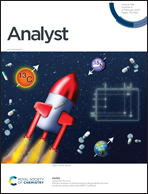Fabrication and development of a microfluidic paper-based immunosorbent assay platform (μPISA) for colorimetric detection of hepatitis C†
Abstract
Paper-based microfluidics is an emerging analysis tool used in various applications, especially in point-of-care (PoC) diagnostic applications, due to its advantages over other types of microfluidic devices in terms of simplicity in both production and operation, cost-effectiveness, rapid response time, low sample consumption, biocompatibility, and ease of disposal. Recently, various techniques have been developed and utilized for the fabrication of paper-based microfluidics, such as photolithography, micro-embossing, wax and PDMS printing, etc. In this study, we offer a fabrication methodology for a microfluidic paper-based immunosorbent assay (μPISA) platform and the detection of Hepatitis C Virus (HCV) was carried out to validate this platform. A laser ablation technique was utilized to form hydrophobic barriers easily and rapidly, which was the major advantage of the developed fabrication methodology. The characterization of the μPISA platform was performed in terms of micro-channel properties using bright-field (BF) microscopy, and surface properties using scanning electron microscopy (SEM). At the same time, sample volume and liquid handling capacity were analyzed quantitatively. Ablation speed (S) and laser power (P) were optimized, and it was shown that one combination (10P60S) provided minimal deviation in micro-channel dimensions and prevented deterioration of hydrophobic barriers. Also, the minimum hydrophobic barrier width, which prevents cross-barrier bleeding, was determined to be 255.92 ± 10.01 μm. Furthermore, colorimetric HCV NS3 detection was implemented to optimize and validate the μPISA platform. Here, HCV NS3 in both PBS and human blood plasma was successfully detected by the naked eye at concentrations as low as 1 ng mL−1 and 10 ng mL−1, respectively. Moreover, the limit of detection (LoD) values for HCV NS3 were acquired as 0.796 ng mL−1 in PBS and 2.203 ng mL−1 in human blood plasma with a turnaround time of 90 min. In comparison with conventional ELISA, highly sensitive and rapid HCV NS3 detection was accomplished colorimetrically on the developed μPISA platform.



 Please wait while we load your content...
Please wait while we load your content...